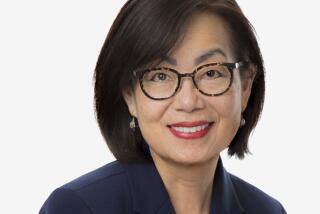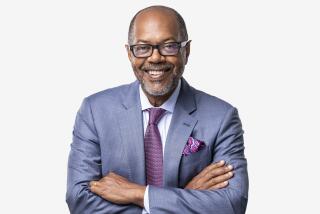William Shawn; Edited New Yorker 35 Years
- Share via
William Shawn, editor of the New Yorker magazine who for decades deftly guided the work of some of the country’s finest writers, died Tuesday.
Shawn, 85, died of a heart attack at his home in New York City, relatives said.
“He was an enormous figure to all of us who worked for him,” said Roger Angell, an editor at the New Yorker since 1956. “He was--there’s no doubt in my mind--the greatest editor of our time.”
Shawn became the magazine’s editor in 1952, and for decades was the shy, retiring heart of the nation’s best known literary publication. He commissioned every article, approved every word on every page, stroked every writer and artist--among them Truman Capote, J. D. Salinger, John Updike, Rachel Carson, John Hersey and James Baldwin.
He ascended to the top job at the New Yorker after the death of the magazine’s rough-hewn founding editor, Harold Ross. He held the job until 1987, when he was forced to retire two years after the magazine was sold to publishing magnate S. I. Newhouse Jr.
During his tenure, Shawn brought in new contributors, made the New Yorker a strong voice against the Vietnam War and strengthened the magazine’s fiction and reporting, although humor remained a mainstay.
Shawn was born in Chicago on Aug. 31, 1907. He dropped out of the University of Michigan after two years and worked as a reporter for small newspapers and as a composer for ballet and theater companies.
He joined The New Yorker in 1933, eight years after it was founded, as a reporter for the “Talk of the Town” section. He turned in notes that were rewritten into articles, for which he was paid $2 per column inch.
A shy, reticent man known to his staff as “Mr. Shawn,” he befriended and encouraged a wide array of talented writers, from the reclusive Salinger, who dedicated one of his books to him, to novelists Updike and Capote.
In 1945, Shawn persuaded Ross to print Hersey’s searing account of the atomic bombing of Hiroshima. The piece dominated an entire issue of the magazine and underlined the danger of atomic warfare. Writer Bruce Bliven Jr. said Shawn, his friend for 40 years, also was largely responsible for the magazine’s coverage of World War II.
Shawn published Carson’s “Silent Spring,” which warned of the dangers of DDT and virtually created a school of environmental journalists, and Baldwin’s penetrating essay on American race relations, “The Fire Next Time.”
As editor, Shawn dominated the magazine, imposing rigid separation between the editorial and business departments.
“The New Yorker is a letter from a group of friends talking about what is important to them that week,” publishing executive George J. Green said in 1987.
Media critic Ben Bagdikian said that under Shawn the magazine “gave writers extraordinary freedom to take time and effort to become extremely knowledgeable in their research, and gave them time to say what they wanted to say.”
Unlike virtually all other large magazines, which often are guided by marketing polls, the New Yorker under Shawn’s tutelage never held editorial meetings to decide what the magazine should be writing about or what the reader wanted, choosing instead to present itself as a forum for writers.
“We edit the New Yorker as a magazine for readers, not as an advertising medium,” Shawn wrote in an anonymous Talk of the Town essay soon after Newhouse bought the magazine. “We have never published anything in order to sell magazines . . . (or) to be ‘successful.’ ”
Some writers described Shawn, a small, balding man with a tendency to blush easily, as “something out of the 19th Century.” A standard joke was that if you were in an elevator and there were three people and Shawn, you might feel there were only three people.
In all his years at the New Yorker, Shawn wrote just one signed piece, a brief story that described the destruction of New York City by a meteor. It carried only the initials, “W. S.” For a long time Shawn shied away from taking strong political stands in the magazine, but the New Yorker opposed the Vietnam War.
In 1985, when it was announced that the magazine had been sold to Newhouse, the new owner said he intended to maintain the magazine’s traditional independence and hoped to retain Shawn as editor.
Two years later, without warning, Newhouse announced that Shawn had decided to retire and would be replaced by Robert Gottlieb, the president and editor in chief of Alfred A. Knopf publishers. Shawn told staff members that he had, in effect, been forced to retire.
More than 170 staff members and contributors wrote to Gottlieb, objecting to how Shawn had been treated and asking that he turn down the position. Gottlieb refused and a number of New Yorker editors and writers quit in protest.
Last June, it was announced that Gottlieb had differences with Newhouse over the magazine’s direction. He was replaced by Tina Brown, editor of Vanity Fair, a more flashy Newhouse publication.
On Tuesday, Brown called Shawn “probably the greatest magazine editor who ever lived and one of the most important figures in American letters this century.”
In 1987, the reclusive Shawn characteristically declined to take part in a farewell party New Yorker staffers gave in his honor, but sent a note explaining that his “feelings at this perplexed moment are too strong for farewells.
“What matters most is that you and I, working together, taking strength from the inspiration that our first editor, Harold Ross, gave us, have tried constantly to find and say what is true.”
After leaving the magazine, Shawn worked as an editor at Farrar, Straus & Giroux, a publishing house that often works with New Yorker writers.
Shawn in survived by his wife, Cecille Lyon; a daughter, Mary, and sons Wallace, an actor and playwright, and Allen, a composer.
More to Read
Sign up for our Book Club newsletter
Get the latest news, events and more from the Los Angeles Times Book Club, and help us get L.A. reading and talking.
You may occasionally receive promotional content from the Los Angeles Times.









